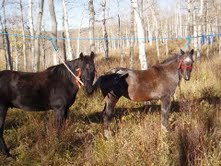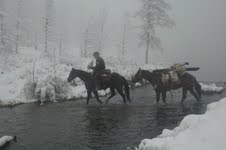Part Two: Heading to the Backcountry
Horses in Camp
 The number one rule is to keep one horse tied to something at all times. This gives you one to ride if the rest get away. Be watchful as horses are great escape artists. The National Forest Service has a very limited number of campgrounds with horse corrals. Horses are not allowed within any USNF campground so using a camp at an edge location where you can picket the horses outside of the camping area.
The number one rule is to keep one horse tied to something at all times. This gives you one to ride if the rest get away. Be watchful as horses are great escape artists. The National Forest Service has a very limited number of campgrounds with horse corrals. Horses are not allowed within any USNF campground so using a camp at an edge location where you can picket the horses outside of the camping area.
You can use baling twine to tie logs to trees in a standing position and build a corral next to camp and you won’t need a high line. Do NOT use nails or wire or the USNF Service considers it a “permanent” fixture which is not allowed. Cut the twine to let the logs fall to the ground and be sure to take the twine home when you’re packing to leave.
If you have the misfortune of having a horses die while in an established campground, it must be removed. If it happens in the forest, notify the nearest ranger station of the horse’s location so they can take the necessary steps to dispose of it.
Where there are ropes, horses get tangled which is why using cotton ropes is important. If using picket pegs, be sure to keep them far enough apart to prevent one horse from entering another’s territory. Check them often because even the experienced horse occasionally gets tangled. Watch your horse’s reactions when first being peg picketed as not all horses will accept the pegging hobble idea. The nature of the beast is to fight the restraint and this can lead to serious injury in some cases.
Take turns caring for the horses. They need water in the morning before leaving camp, again at mid-day and in the evening. Do not leave horses peg picketed while away from camp. Do this while you are fixing lunch and taking a rest before heading back out to hunt. Horses need about 1-1/2 hrs. to eat enough hay (morning and night) or 2-3 hrs. 2x per day when grazing. Feed them their ration of grain before the hay or grazing.
Basic Packing Need-to-Know
 There are all kinds of videos, DVDs, books and articles about basic packing with horses. Each pack trip is different and you’ll be presented with new situations each time.
There are all kinds of videos, DVDs, books and articles about basic packing with horses. Each pack trip is different and you’ll be presented with new situations each time.
Be sure to know the following:
Exactly where your camp will be and the amount of forage and water available. (USFS states camps should be at least 100 ft. from a trail or body of water) Pre-scouting is critical. Where there was good grass last year doesn’t mean its there this year.
How-to tie the “one-man diamond hitch”, the “barrel hitch” and “basket hitch”. Practice these hitches at home until you know them like the back of your hand. Use horses if you’ve got them. A bucket or barrel stabilized on a sawhorse works too.
How-to properly balance the load using a good scale for accuracy; each side should be within a few pounds of the other.
How-to make adjustments to pack saddle rigging so it fits correctly.
How-to release a hitch quickly and safely without having to cut the rope (last resort) in case of a wreck.
How-to care for horses in a camp environment.
How-to set up and safely use a “high line” for picketing horses (which the National Forest Service encourages over any other way of keeping horses in or outside of camp).
How-to safely tie a horse to a tree to assure it will be there when you are finished loading or unloading.
Note: The USFS does not approve of tying a horse tied to a tree for prolonged period as the horse damages the tree.
How-to string and use a food rope in camp to protect your food as well as grain from the weather and critters. Hang saddles off the ground where porcupines cannot access the leather (they gnaw at the sweat salt not caring how much leather they ruin).
How-to safely load meat on a horse.
Save time packing panniers equally by weighing and labeling all gear at home.
How-to use ground pickets for grazing horses when staying in camp.
Reference Materials
Websites:
There are instructional videos on YOUTUBE for topics like: tying a diamond hitch, tying a basket hitch, tying a barrel hitch, tying a horse to a tree, tying a high line for horse camping, replacing a horse shoe and just about anything else you can think of.
-
Books:
“Horses, Hitches, and Rocky Trails: The Original Guide to Packing” by Joe Back - “Horse Camping” by George B, Hatley, Lewis Portney, Juli S. Thorsen
- “Packin’ in on Mules and Horses” by Smoke Elser and Bill Brown
- “Horse Packing in Pictures” by Francis W. Davis
- “Packing & Outfitting Field Manuel” by Oliver C. Hill
Video:
“Packing Horses & Mules for the Back Country Volume I” presented by Brandon Carpenter
Wrap Up
 Hunting with pack horses isn’t as complicated as it sounds. It takes planning and a lot of preparation, plus there’s extra work when keeping horses in camp…but it’s a great experience! Good luck, have fun, be safe, use common sense and wherever you end up practice “leave no trace” camping. Enjoy our beautiful Colorado!
Hunting with pack horses isn’t as complicated as it sounds. It takes planning and a lot of preparation, plus there’s extra work when keeping horses in camp…but it’s a great experience! Good luck, have fun, be safe, use common sense and wherever you end up practice “leave no trace” camping. Enjoy our beautiful Colorado!

